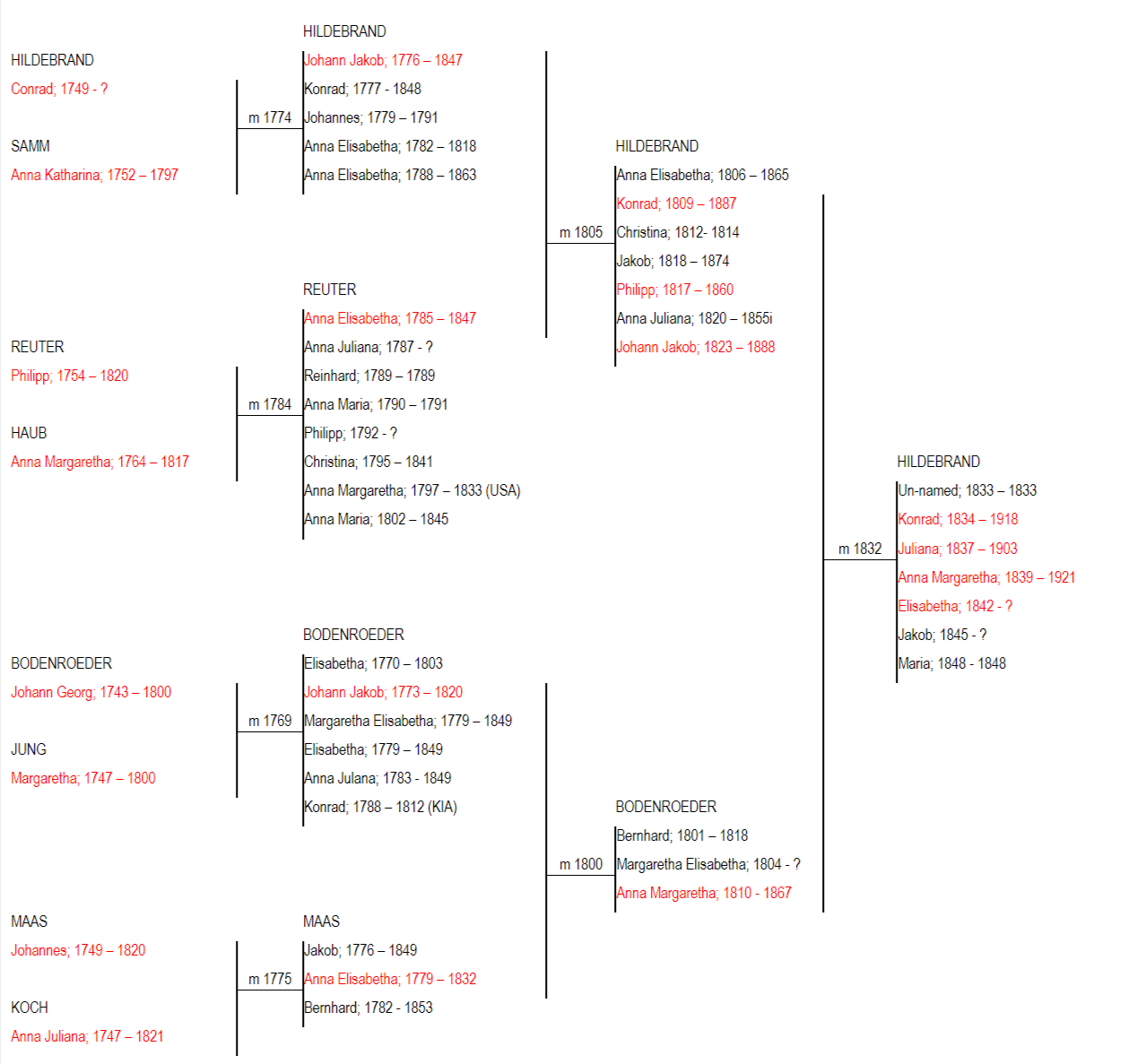Juliana HILDEBRAND 1837-1903
Juliana was the eldest daughter of Konrad Hildebrand I and Anna Margaretha nee Bodenroeder, descendants of two families which had farmed in the Wetterau Valley for generations – the Hildebrands in Nieder-Weisel, the Bodenroeders in the tiny hamlet of Bodenroed from which the family took its name. Like so many of their forebears, Konrad and Margaretha were married during the Festival of the Harvest in late November 1832. A female child, too premature to survive, was born ten months later, followed by a son, Konrad born 1834, and a daughter, Juliana, on 5th April 1837. There were to be four more children during the next decade, the first of these being Anna Margaretha born 28th December 1839. The three children named were destined to become part of the migration to Victoria.
Juliana was the first to depart, leaving from the German port of Hamburg on the tiny barque “Luise” on 11th October 1854. She travelled with two other teenagers, Susanna Wilhelm and Elisabetha Reuter, and the trio was well chaperoned by three of Juliana’s uncles. A slow and uncomfortable voyage ended in Melbourne on 23rd February 1855. Juliana’s brother and sister came out together 17 months later.
On 12th March 1859, Juliana was married in Ballarat, where many of the Nieder-Weiselerns settled. The celebrant was Pastor J Niquet of the Lutheran Church in Ballarat. Other couples who exchanged vows on that sunny Saturday afternoon included Jakob Heinz – who had been on “Luise” with Juliana – and Dorothea Giehl, both from Nieder-Weisel. Juliana’s groom was George Joseph Paravicini, 23. From a farming background in Poschiavo, Switzerland, he came out aboard “Shooting Star” in February 1857 and, like most migrants, was trying his luck on the goldfields. He was scion to a family whose name recurs in Swiss archives for almost a millennium.
Juliana’s siblings may have timed their return to Germany to fit in with her wedding plans – they were both back in Nieder-Weisel by 1861, in which year each of them married.
Joseph continued his mining activities into the Daylesford area; Juliana gave birth to a daughter, Elizabeth, in 1860 at Hepburn. Then, as the alluvial gold ran out, they moved into southeastern New South Wales, then north to Grenfell and on to Forbes. Their daughter died soon after her first birthday, but Juliana had four more children during their northward migration – Emilia in 1862, Joseph in 1864, Annie Julia in 1867, and Julia in 1870. A second son, Geo. Peter, was born in 1872 at Woodstock, north of Cowra, after which Joseph and Juliana finally settled in Parkes.
Joseph must have had reasonable success mining, as he was able to acquire land on which to build one of the first public houses in the town, the Parkes Hotel. As part of this process, Joseph took out naturalisation papers in 1875. Juliana had two more children in their Forbes Street home – her fifth daughter, Martha in 1875 and her third son, William (Ernie) in 1878.
Joseph later resumed his occupation of farming, taking up a land selection on the Coobang Creek, west of Parkes, which he worked until the children were adults; he and Juliana then retired back to Parkes. From about 1895 they lived in Currajong Street and it was here that Juliana died on 21st July 1903, in her 67th year. Of her children, Martha immigrated to South Africa with her engineer husband; Emilia and Annie Julia died in their twenties; each of the boys married and had families; Julia, who had never married, kept house for her father until his death in 1914. An indication of the high esteem in which the Parkes community held Joseph can be seen in the press reports of his death; all businesses in the town closed during the funeral service.
View Juliana's Family Chart

